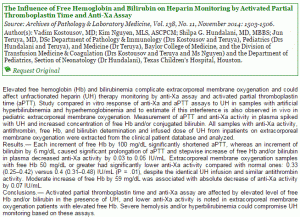This is from friend and colleague, Dean Willett, Instrumentation Laboratory:
Hi, George; A few points to consider…
There are two potential sources of interference here: biochemical and optical. Much like hemolysis, if the sample contains biochemical interference, results will be affected regardless of detection method. In the absence of any data it’s not clear if this drug introduces such a biochemical interference.
A recent publication suggests that the presence of free hemoglobin and bilirubin could affect partial thromboplastin times (PTTs, APTTs) on mechanical test systems (see below). This would be an example of a potential biochemical interference that people might be missing if they assume that mechanical detection systems are not affected by hemolysis.
The potential for optical interference might be mitigated in assays run at 671 nm as Ali points out. Another variable is the sample dilution. More dilute assays, run at the higher wavelength might be even less affected. Again, without any data it’s not possible to make any claims.
Keep in mind that most companies run chromogenic assays at 405 nm. Again, mechanical vs optical would be irrelevant here. My best, Dean.



No comments here.